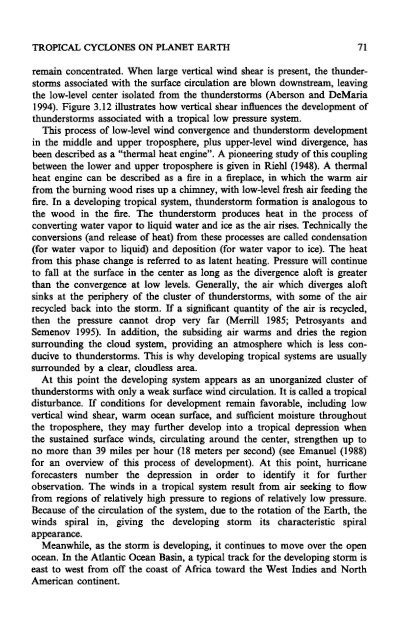Hurricanes: Their Nature and Impacts on Society - Climate Science ...
Hurricanes: Their Nature and Impacts on Society - Climate Science ...
Hurricanes: Their Nature and Impacts on Society - Climate Science ...
You also want an ePaper? Increase the reach of your titles
YUMPU automatically turns print PDFs into web optimized ePapers that Google loves.
71<br />
TROPICAL CYCLONES ON PLANET EARTH<br />
remain c<strong>on</strong>centrated. When large vertical wind shear is present, the thunderstorms<br />
associated with the surface circulati<strong>on</strong> are blown downstream, leaving<br />
the low-level center isolated from the thunderstorms (Abers<strong>on</strong> <str<strong>on</strong>g>and</str<strong>on</strong>g> DeMaria<br />
1994). Figure 3.12 illustrates how vertical shear influences the development of<br />
thunderstorms associated with a tropical low pressure system.<br />
This process of low-level wind c<strong>on</strong>vergence <str<strong>on</strong>g>and</str<strong>on</strong>g> thunderstorm development<br />
in the middle <str<strong>on</strong>g>and</str<strong>on</strong>g> upper troposphere, plus upper-level wind divergence, has<br />
been described as a "thermal heat engine". A pi<strong>on</strong>eering study of this coupling<br />
between the lower <str<strong>on</strong>g>and</str<strong>on</strong>g> upper troposphere is given in Riehl (1948). A thermal<br />
heat engine can be described as a fire in a fireplace, in which the warm air<br />
from the burning wood rises up a chimney, with low-level fresh air feeding the<br />
fire. In a developing tropical system, thunderstorm formati<strong>on</strong> is analogous to<br />
the wood in the fire. The thunderstorm produces heat in the process of<br />
c<strong>on</strong>verting water vapor to liquid water <str<strong>on</strong>g>and</str<strong>on</strong>g> ice as the air rises. Technically the<br />
c<strong>on</strong>versi<strong>on</strong>s (<str<strong>on</strong>g>and</str<strong>on</strong>g> release of heat) from these processes are called c<strong>on</strong>densati<strong>on</strong><br />
(for water vapor to liquid) <str<strong>on</strong>g>and</str<strong>on</strong>g> depositi<strong>on</strong> (for water vapor to ice). The heat<br />
from this phase change is referred to as latent heating. Pressure will c<strong>on</strong>tinue<br />
to fall at the surface in the center as l<strong>on</strong>g as the divergence aloft is greater<br />
than the c<strong>on</strong>vergence at low levels. Generally, the air which diverges aloft<br />
sinks at the periphery of the cluster of thunderstorms, with some of the air<br />
recycled back into the storm. If a significant quantity of the air is recycled,<br />
then the pressure cannot drop very far (Merrill 1985; Petrosyants <str<strong>on</strong>g>and</str<strong>on</strong>g><br />
Semenov 1995). In additi<strong>on</strong>, the subsiding air warms <str<strong>on</strong>g>and</str<strong>on</strong>g> dries the regi<strong>on</strong><br />
surrounding the cloud system, providing an atmosphere which is less c<strong>on</strong>ducive<br />
to thunderstorms. This is why developing tropical systems are usually<br />
surrounded by a clear, cloudless area.<br />
At this point the developing system appears as an unorganized cluster of<br />
thunderstorms with <strong>on</strong>ly a weak surface wind circulati<strong>on</strong>. It is called a tropical<br />
disturbance. If c<strong>on</strong>diti<strong>on</strong>s for development remain favorable, including low<br />
vertical wind shear, warm ocean surface, <str<strong>on</strong>g>and</str<strong>on</strong>g> sufficient moisture throughout<br />
the troposphere, they may further develop into a tropical depressi<strong>on</strong> when<br />
the sustained surface winds, circulating around the center, strengthen up to<br />
no more than 39 miles per hour (18 meters per sec<strong>on</strong>d) (see Emanuel (1988)<br />
for an overview of this process of development). At this point, hurricane<br />
forecasters number the depressi<strong>on</strong> in order to identify it for further<br />
observati<strong>on</strong>. The winds in a tropical system result from air seeking to flow<br />
from regi<strong>on</strong>s of relatively high pressure to regi<strong>on</strong>s of relatively low pressure.<br />
Because of the circulati<strong>on</strong> of the system, due to the rotati<strong>on</strong> of the Earth, the<br />
winds spiral in, giving the developing storm its characteristic spiral<br />
appearance.<br />
Meanwhile, as the storm is developing, it c<strong>on</strong>tinues to move over the open<br />
ocean. In the Atlantic Ocean Basin, a typical track for the developing storm is<br />
east to west from off the coast of Mrica toward the West Indies <str<strong>on</strong>g>and</str<strong>on</strong>g> North<br />
American c<strong>on</strong>tinent.














